
A story where fact meets fiction, by Boris O. Dittrich
For Jehoshua Rozenman, his Out of the Box project is like a strange suitcase he has found in the basement of his studio. In his mind, he forces the locks and finds inside a whole range of mysterious old magazines, black-and-white photographs, blueprints of buildings, drawings and picture postcards. The wide range of items in this unfamiliar archive has provided an inexhaustible supply of inspiration for his work.
This story, especially for the exhibition Jehoshua Rozenman - Out of the Box, explores the concept of the suitcase in more depth. Artist Jehoshua Rozenman and writer Boris O. Dittrich challenge you to engage in a dialogue with your own expectations. What do you think the suitcase contains? Is it fact or fiction?
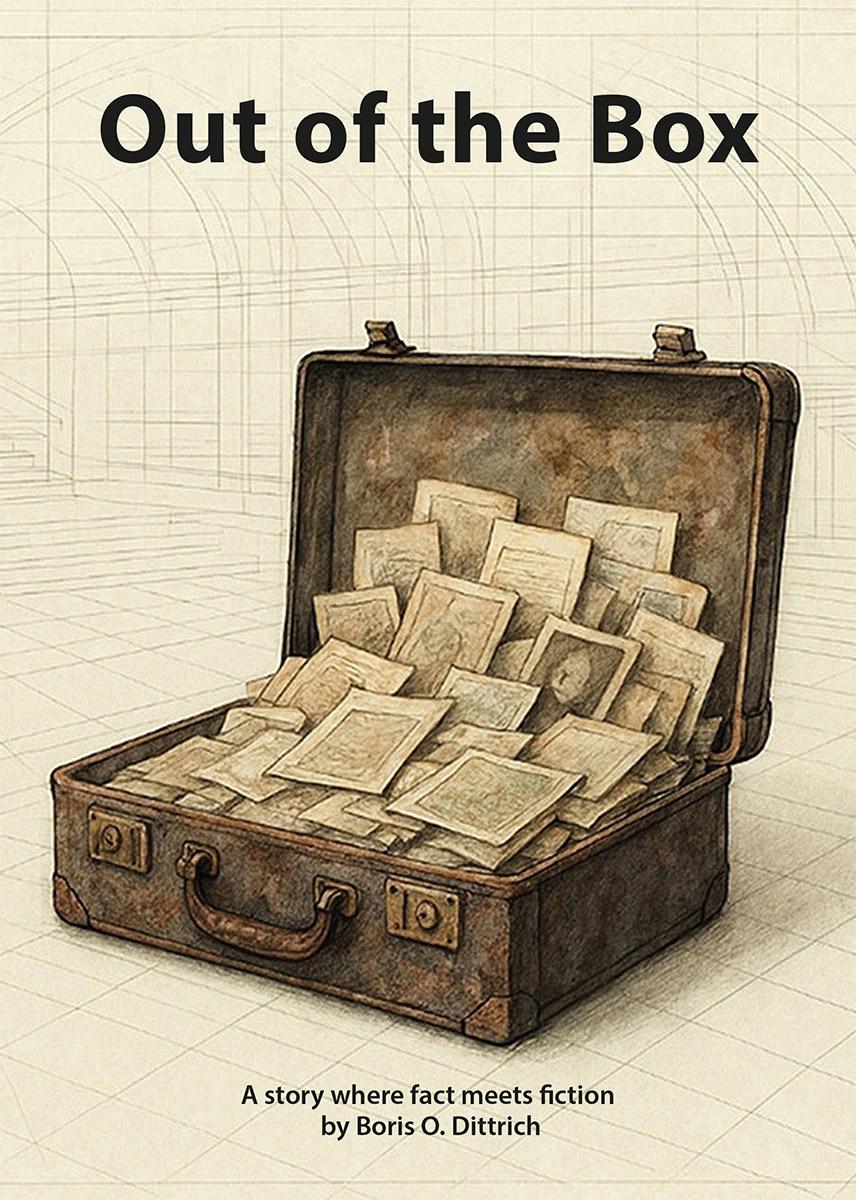
Out of the Box
Written by Boris O. Dittrich
‘Where did you find the suitcase? We’re here at the studio of sculptor Jehoshua Rozenman in Berlin, which he shares with three other artists. We’re surrounded by recent sculptural work.’
We enter the studio via a shop door. In the space at the front, Rozenman’s fellow artists display their pots, dishes, plates and vases. They sometimes sell them to the public. The camera zooms in on a sculpture made of glass, aluminium and wood. It resembles a building, a ruin, but there is also something akin to a living organism about it. The form is abstract, but recalls something architectural. Frau Wietersheim, the director of a large art institution in Berlin, holds her microphone to Rozenman’s mouth. She is at the studio to make a video for his exhibition. She has a separate screening room at the institute where the public can watch the video. Rozenman’s drawings, watercolours, sketches, blueprints and other writings will be displayed in the exhibition space on the ground floor. The sculptures will stand on plinths spread across several rooms. Rozenman looks at her somewhat diffidently, as if he were embarrassed to have to give an interview about his work. As if he were thinking, ‘If only I were alone in my studio where I could work in peace on my last sculpture’.
‘I believe you’re inspired by the past? Does that have to do with the suitcase?’
‘During Covid the shop was closed to the public. We spent days on end here, at a safe distance from each other, working on our own things. My spot is at the front, near the window. My colleagues work in the back rooms. At some point one of them said, “Now there’s no one coming and it’s so quiet, it might be a good time to tidy up the basement. We can put out all the crap we’ve stored there for the past ten years to be collected.” No sooner said than done. It was the first time I’d spent an entire day in the basement, sorting stuff out. Our studio has been here for fifteen years. Before that it was a butcher’s shop, and before that, a bakery. That went right back to the time of the Second World War. Before then, it was a house.’
Frau Wietersheim interrupts him. She apparently thinks he is digressing too much.
‘So back to my question. Can you tell us what was in the suitcase?’
As Rozenman talks, the camera pans round and Frau Wietersheim’s assistant films the entire front space of the studio. On the wall there are shelves full of pots, dishes, vases and also tubes of paint, rolls of paper, books and an old radio. A large industrial vacuum cleaner stands on the floor. The impression is of a slightly untidy yet organised place.
‘There are several rooms in the basement. No windows, no daylight. In the back room I found an old wooden suitcase, with the word ‘Architektura’ written on it in white paint. That word aroused my curiosity. What language was it? What was in the suitcase? It was heavy and it took three of us to lug it upstairs. It was locked with two iron padlocks, and I didn’t have a key, so I forced the locks in order to open it.’
In the meantime, the assistant with the camera leaves the front room and goes into the back, where the rest of the studio is situated. Rozenman turns, finding it difficult to concentrate.
‘Where’s he going? My colleagues don’t want to be filmed.’
Frau Wietersheim calls her assistant back. ‘Christian, come back here please.’
Christian looks offended, and sighs as if his creativity were being stifled. At that moment, a bell rings as the shop door opens.
‘Stop,’ Frau Wietersheim cries, clearly disconcerted. Christian takes off his equipment and puts that camera on the floor. Everyone turns to the doorway. Two civilian patrol officers enter the shop. ‘Who does that car parked on the pavement belong to?’
Frau Wietersheim jumps up, humbly offers an apology and says that she will move the car immediately. ‘We had to unload the lights and other equipment. They’re heavy, so that’s why we stopped there for a moment.’
‘Oh, I know you from TV,’ the first officer says with a smile. ‘From that programme with the art reports.’
‘That’s right. We’re interviewing sculptor Jehoshua Rozenman about his work right now.’ She indicates the sculptures displayed here and there. The two patrol officers glance around, uninterested. ‘We’re also going to use the footage in the art segment of the TV programme.’
‘Is that modern art?’ the second patrol officer mumbles. They put the ticket book away and go outside with Frau Wietersheim. Christian notices Rozenman’s irritated look and shakes his head.
‘Where’s that suitcase? Do you still have it? I could take a few shots of it now.’
Rozenman shrugs. ‘No. The suitcase’s in Amsterdam. I didn’t find it here.’
‘Huh?’ Christian says, surprised. ‘But....’ At that moment his phone rings and he turns towards the shop window, staring into the street as he answers in a loud voice. Rozenman uses the opportunity to place a pile of watercolours, drawings, blueprints, sketches and architectural plans on his desk. He intends to show them to Frau Wietersheim during the interview. He gathers the coffee cups and washes them in the kitchen. As he walks back to the front room, he hears the bell over the shop door. Frau Wietersheim comes in.
‘Let’s get on, we don’t have much time. I’ve parked round the corner.’
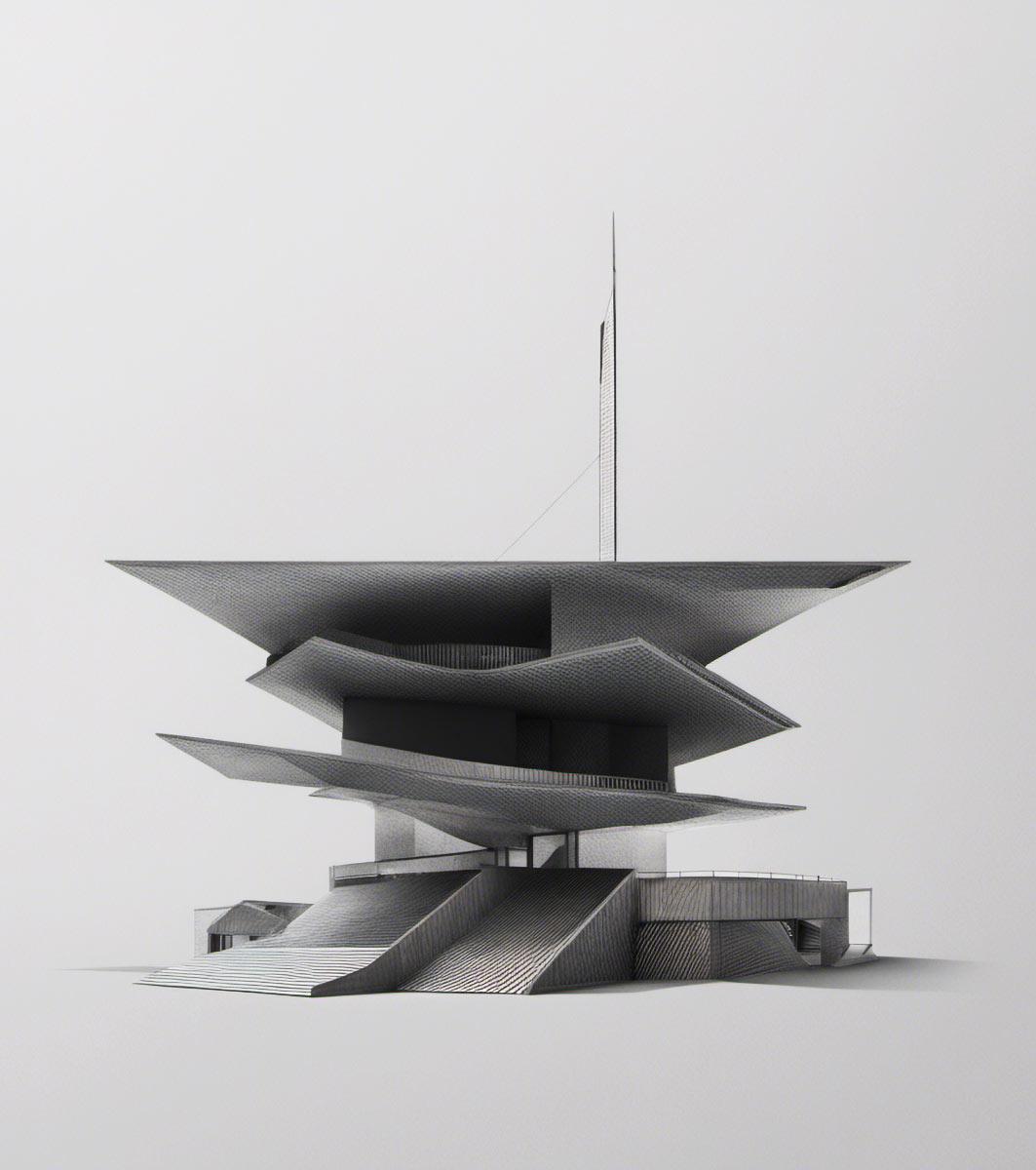
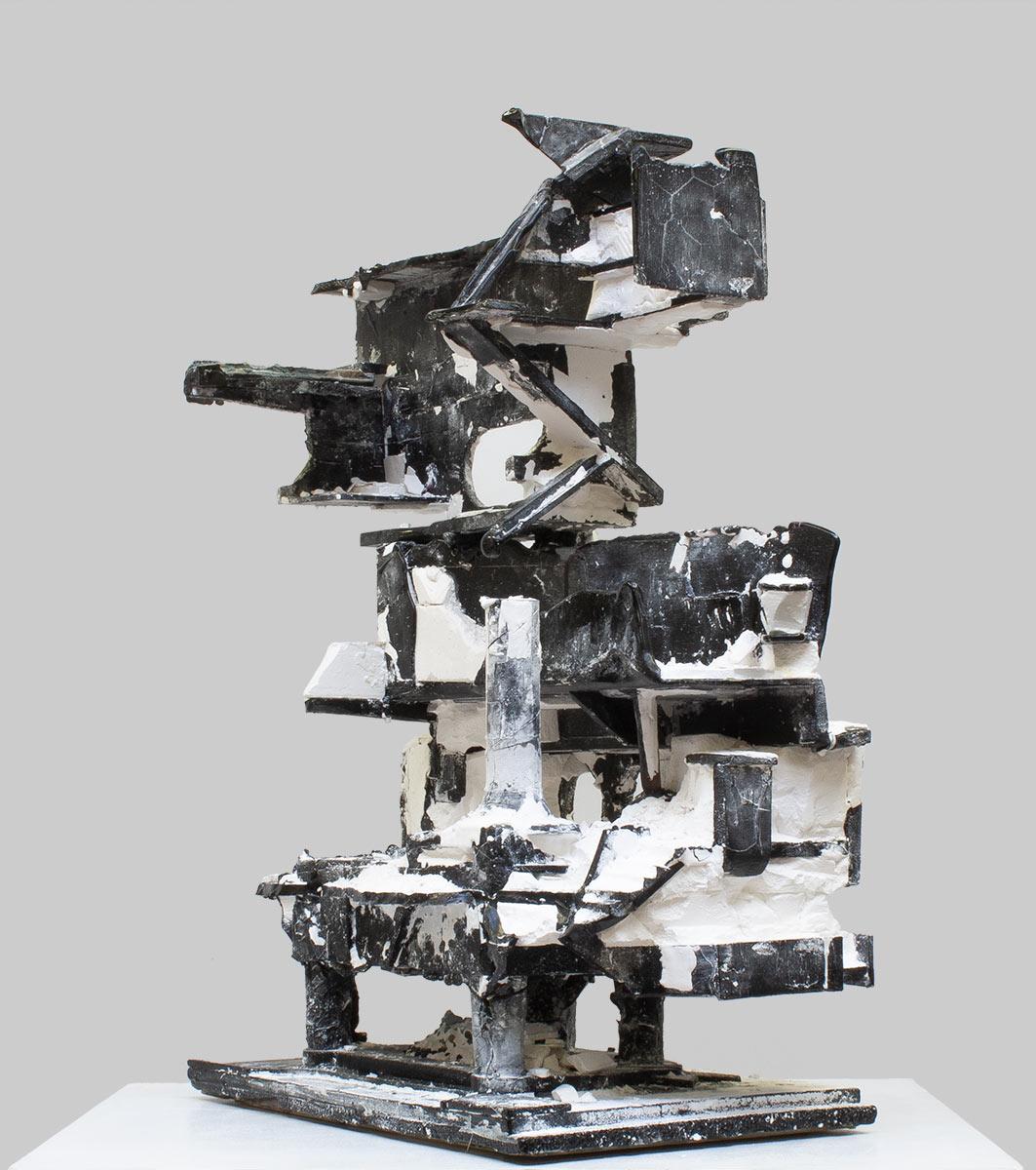
She returns to the chair where she was sitting before and passes her hand through her curls. ‘Is my hair okay, Christian?’ she asks her assistant, who is now standing behind Rozenman with the camera on his shoulder. Her tone does not invite an honest response.
‘Great. We can continue,’ he says. ‘But maybe you should stick to the subject of the suitcase a little longer.’
Frau Wietersheim raises her hand, as if to silence him. ‘Leave the interview to me, Christian. Everyone has their own job to do.’ And then she continues, ‘One, two, three.’
The light on the camera comes on and she smiles broadly, flashing her brilliant white teeth.
‘Jehoshua Rozenman, so you managed to open the suitcase. What did you find?’
‘There was all sorts in it. Old magazines from the 1930s to the 1980s, black-and-white photos of buildings in Berlin, blueprints, drawings, watercolours. Oh yes, and old-fashioned magazines and picture postcards from different parts of the world too, like 1930s Bauhaus buildings in Tel Aviv. And a book by Franz Kafka, The Trial.’
Frau Wietersheim notices the pile of papers on the desk.
‘Is this them?’
Rozenman stands up. Frau Wietersheim walks over to the pile of papers and carefully picks up the one on top, an old drawing.
‘It looks old and worn, with brown edges, like it was rescued from a fire.’ Then she picks up a watercolour of a futuristic building and holds it up to the camera.
‘I wonder what period this is. So this was all in the suitcase? Where is it actually? I want Christian to film it.’ She gives her assistant a peremptory glance.
‘Oh, the suitcase isn’t here. I asked the seller to send it straight to my other studio in Amsterdam.’
Frau Wietersheim raises her eyebrows. She frowns and gives Rozenman a surprised look.
‘What do you mean seller? You found the suitcase here in the basement, didn’t you?’
It is Rozenman’s turn to look surprised. ‘Didn’t my dealer tell you?’
‘What?’
‘I made the whole thing up’, Rozenman replied.
Frau Wietersheim brings her hand down on the pile of papers. ‘What about this then? This is real, isn’t it? This isn’t made up?’
‘I made up the story of the suitcase. Why? Because the story of the suitcase is a metaphor. You see, art is a combination of concept, imagination and skill. All my sculptures have architectural elements, and I wanted to create a framework for that. I didn’t just want to make sculptures, I also wanted to come up with a theme for a series of sculptures with a narrative. So I wanted to create a situation that’s the equivalent of finding a suitcase and its contents. That’s why I asked several artists, architects and illustrators to produce their impression of a model of a sculpture I gave them. They were free to do whatever they wanted, with no instructions from me. All the material they gave me was a surprise, like opening a suitcase full of unknown material. Then their drawings, watercolours, sketches and blueprints inspired me, and I used them to make the models of my sculptures. My project is the combination of all this.’
Frau Wietersheim points to a green sculpture made of glass. ‘You made this sculpture recently, didn’t you? Is it the result of a combination of a drawing by the architect and your own design?’
‘Yes, I’m the creator. I use my imagination. And in almost every case I was also influenced by the material I got from them.’
‘I’m finding it difficult to follow.’ She casts Christian a quick glance.
‘But now I see all this, I don’t know whether to believe you. Is it real or not? If the suitcase and its contents turn out to be real after all, I’ll be creating problems for myself if I exhibit it at my institution.’
Rozenman looks at her expectantly.
‘I don’t mean to insult you,’ she continues, ‘but imagine someone comes to the exhibition and says, “Wait a minute, this is my grandfather’s suitcase that he hid in the basement in the Second World War! He was an architect and he wanted to makes sure the contents were safe. What am I supposed to do then?’
‘That won’t happen, it’s all fantasy.’
‘Well, you say that now. But you might have made up the bit about making it up to hide the fact that you used other people’s work.’
‘So my artistic imagination is being used against me now?’
Frau Wietersheim reflects quietly for a moment. Christian seems curious as to how she will respond, and looks at her apprehensively.
‘I want to know for certain. What I need is statements from all the people who worked on your project confirming that it happened as you say. I’ll have a leg to stand on then if anyone has a claim to the suitcase and its contents. I’ve had experience of artists committing plagiarism at our institution before. I want to make sure that doesn’t happen.’
Rozenman hesitates. ‘I thought up the entire concept. It’s part of my creative process. This is art. It would be making my project into a legal affair if you asked other people to start making statements.’
Frau Wietersheim ignores his objections.
‘And what about this pile of papers? There are magazines from decades ago here. They’re real. They’ve not been made up. All those drawings, sketches, watercolours and whatnot look like a complete hotchpotch, if I’m honest.’
‘No, it isn’t. On the contrary’, Rozenman replies, irritated. He does not respond to what she said earlier, only her last comment. ‘It was clearly a collection. I suspect it belonged to an architect or someone who was very interested in architecture. Lots of the articles in the magazines were about Italian futurism, brutalism, Bauhaus, modernism.’
‘Who did the collection belong to?’
‘I don’t know. The articles are about all different architectural periods. They cover decades. The postcards of the buildings in Tel Aviv had been sent to Otto Karman at this address. But I wasn’t able to find out anything about him when I looked into it. One of the experts I talked to thought it might have been an alias for someone who lived here during the war.’
‘Stop,’ says Frau Wietersheim. ‘Stop filming,’ she cries. The camera light goes out. Christian places the camera on the ground before him and rubs his shoulder. Then Frau Wietersheim turns to Rozenman and says, ‘We can’t use this in the video. It’s very intriguing, and something like this is super-sensitive in Germany. People might start thinking that the architect’s legacy, the contents of the suitcase, has been stolen. Then we’ll get demonstrations at the opening. That really wouldn’t do. I have to think of our funding, I can’t jeopardise it. It’s tempting to explore the story further, but we really could end up with protests, or worse. I don’t want the exhibition to be boycotted, whether the story is made up or not.’
Rozenman looks from her to the assistant and waits.
‘Let’s carry on,’ Frau Wietersheim says decisively after a moment’s reflection. Christian puts the heavy camera back on his shoulder. ‘Camera running!’
‘I would like to talk for a moment about how you create your work. Your sculptures are made of glass, but first you make a wax model and then make a plaster mould over that, which you place in your kiln. You heat the kiln, so only the plaster remains and the wax melts away. Then you lay blocks of glass on it and allow the heat to melt the glass into the hollow spaces in the plaster mould. The process can take days, even weeks. This is how you eventually produce your glass sculpture. All very technical, kiln casting is the name of the method you use. I don’t want to go into that any further, as it's actually something else I’m interested in. What is your source of inspiration? What drives you? What inspires you?’
‘As I said, I did months of research on the contents of the suitcase. I read about different architectural movements, about Prenzlauer Berg in 1930s Berlin, right up to the fall of the Wall. In the meantime I just carried on working on my sculptures. I noticed that, when making the models, I was being influenced more and more by what I’d read and seen. Of course I gave it my own interpretation, but the history had taken root in me.’
‘I understood from our preliminary discussion that the drawings we see here on the wall, the sketches, blueprints and watercolours are not all by you?’
‘That’s right. I invited other artists to take inspiration from my models. I said, “Have a go, make a sketch or drawing based on this model. A model of a building, for example.” I asked a friend who is an architect, for instance. And I asked another friend to make a blueprint based on one of the models that looks like a ruin. She went and worked on it at her own studio. I let them just surprise me, had no idea what they would come back with. It’s similar to the contents of the suitcase. I didn’t know what I would find in there either, and it influenced my models. The inspiration they gave me with their depiction of my models gave me more inspiration. It was a great interaction, just like the documentation in the suitcase.’
‘I understand you also used Artificial Intelligence? Isn’t that dangerous for an artist? Your work might become redundant if AI takes over everything.’
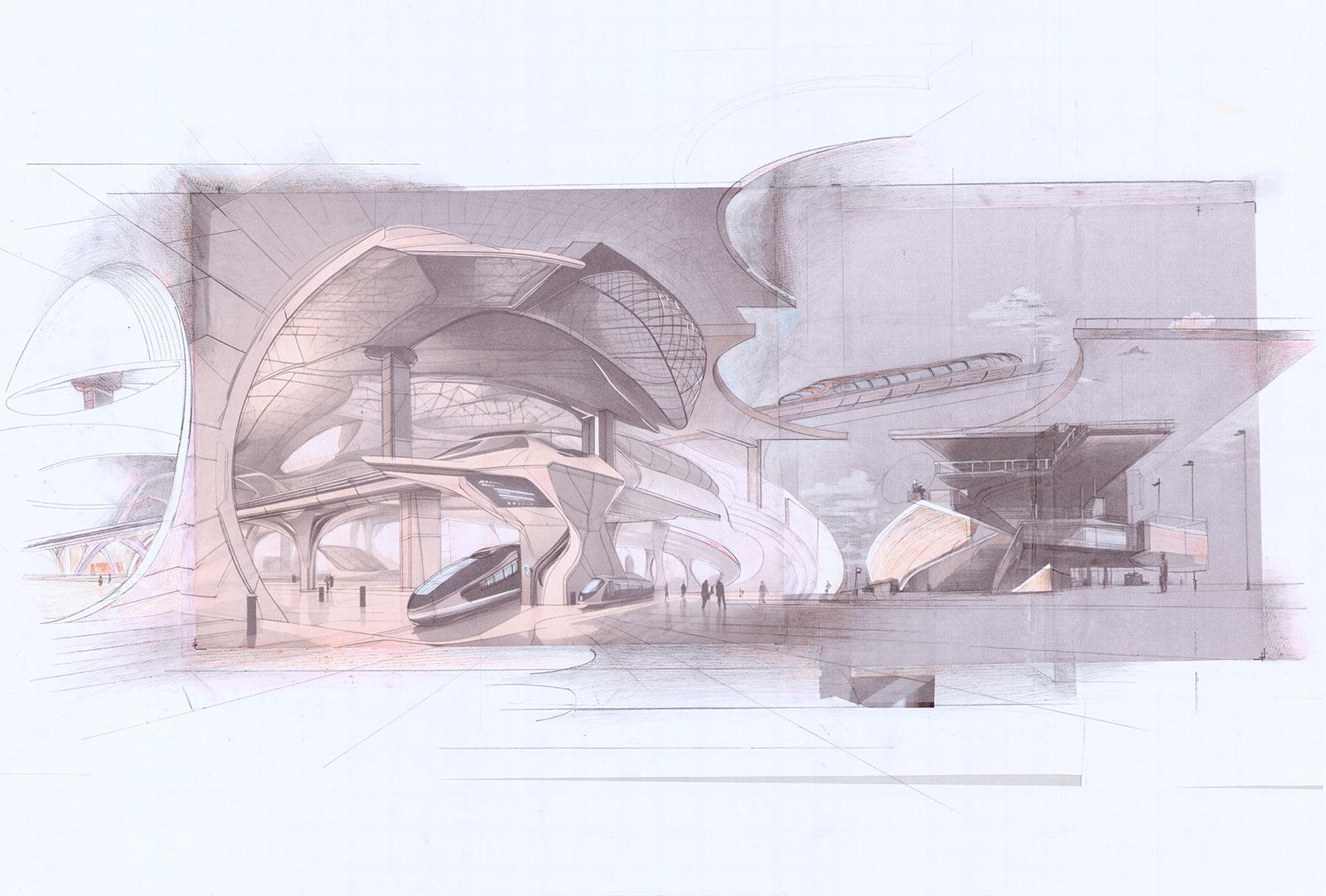
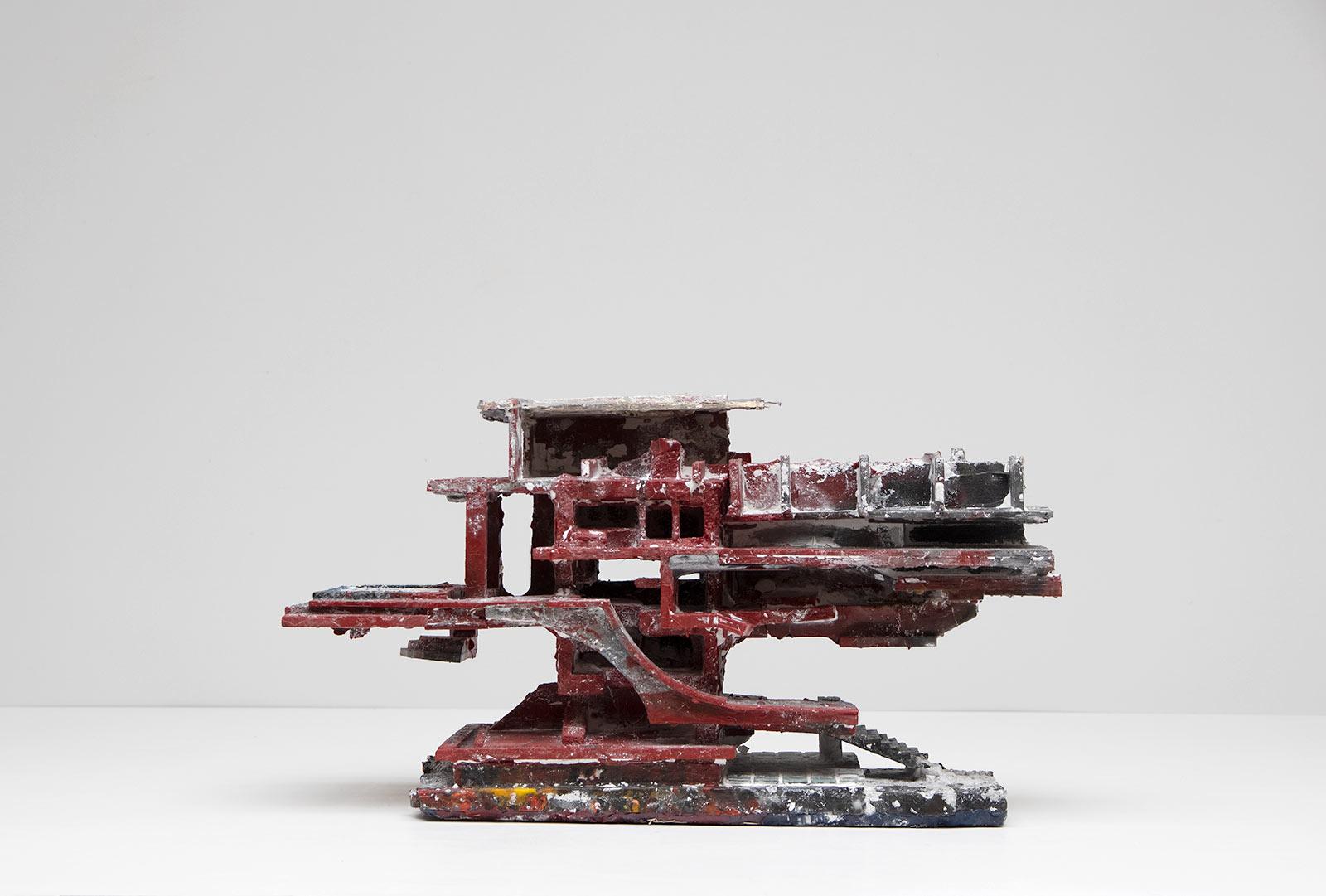
Frau Wietersheim points to a green sculpture made of glass. ‘You made this sculpture recently, didn’t you? Is it the result of a combination of a drawing by the architect and your own design?’
‘Yes, I’m the creator. I use my imagination. And in almost every case I was also influenced by the material I got from them.’
‘I’m finding it difficult to follow.’ She casts Christian a quick glance.
‘But now I see all this, I don’t know whether to believe you. Is it real or not? If the suitcase and its contents turn out to be real after all, I’ll be creating problems for myself if I exhibit it at my institution.’
Rozenman looks at her expectantly.
‘I don’t mean to insult you,’ she continues, ‘but imagine someone comes to the exhibition and says, “Wait a minute, this is my grandfather’s suitcase that he hid in the basement in the Second World War! He was an architect and he wanted to makes sure the contents were safe. What am I supposed to do then?’
‘That won’t happen, it’s all fantasy.’
‘Well, you say that now. But you might have made up the bit about making it up to hide the fact that you used other people’s work.’
‘So my artistic imagination is being used against me now?’
Frau Wietersheim reflects quietly for a moment. Christian seems curious as to how she will respond, and looks at her apprehensively.
‘I want to know for certain. What I need is statements from all the people who worked on your project confirming that it happened as you say. I’ll have a leg to stand on then if anyone has a claim to the suitcase and its contents. I’ve had experience of artists committing plagiarism at our institution before. I want to make sure that doesn’t happen.’
Rozenman hesitates. ‘I thought up the entire concept. It’s part of my creative process. This is art. It would be making my project into a legal affair if you asked other people to start making statements.’
Frau Wietersheim ignores his objections.
‘And what about this pile of papers? There are magazines from decades ago here. They’re real. They’ve not been made up. All those drawings, sketches, watercolours and whatnot look like a complete hotchpotch, if I’m honest.’
‘No, it isn’t. On the contrary’, Rozenman replies, irritated. He does not respond to what she said earlier, only her last comment. ‘It was clearly a collection. I suspect it belonged to an architect or someone who was very interested in architecture. Lots of the articles in the magazines were about Italian futurism, brutalism, Bauhaus, modernism.’
‘Who did the collection belong to?’
‘I don’t know. The articles are about all different architectural periods. They cover decades. The postcards of the buildings in Tel Aviv had been sent to Otto Karman at this address. But I wasn’t able to find out anything about him when I looked into it. One of the experts I talked to thought it might have been an alias for someone who lived here during the war.’
‘Stop,’ says Frau Wietersheim. ‘Stop filming,’ she cries. The camera light goes out. Christian places the camera on the ground before him and rubs his shoulder. Then Frau Wietersheim turns to Rozenman and says, ‘We can’t use this in the video. It’s very intriguing, and something like this is super-sensitive in Germany. People might start thinking that the architect’s legacy, the contents of the suitcase, has been stolen. Then we’ll get demonstrations at the opening. That really wouldn’t do. I have to think of our funding, I can’t jeopardise it. It’s tempting to explore the story further, but we really could end up with protests, or worse. I don’t want the exhibition to be boycotted, whether the story is made up or not.’
Rozenman looks from her to the assistant and waits.
‘Let’s carry on,’ Frau Wietersheim says decisively after a moment’s reflection. Christian puts the heavy camera back on his shoulder. ‘Camera running!’
‘I would like to talk for a moment about how you create your work. Your sculptures are made of glass, but first you make a wax model and then make a plaster mould over that, which you place in your kiln. You heat the kiln, so only the plaster remains and the wax melts away. Then you lay blocks of glass on it and allow the heat to melt the glass into the hollow spaces in the plaster mould. The process can take days, even weeks. This is how you eventually produce your glass sculpture. All very technical, kiln casting is the name of the method you use. I don’t want to go into that any further, as it's actually something else I’m interested in. What is your source of inspiration? What drives you? What inspires you?’
‘As I said, I did months of research on the contents of the suitcase. I read about different architectural movements, about Prenzlauer Berg in 1930s Berlin, right up to the fall of the Wall. In the meantime I just carried on working on my sculptures. I noticed that, when making the models, I was being influenced more and more by what I’d read and seen. Of course I gave it my own interpretation, but the history had taken root in me.’
‘I understood from our preliminary discussion that the drawings we see here on the wall, the sketches, blueprints and watercolours are not all by you?’
‘That’s right. I invited other artists to take inspiration from my models. I said, “Have a go, make a sketch or drawing based on this model. A model of a building, for example.” I asked a friend who is an architect, for instance. And I asked another friend to make a blueprint based on one of the models that looks like a ruin. She went and worked on it at her own studio. I let them just surprise me, had no idea what they would come back with. It’s similar to the contents of the suitcase. I didn’t know what I would find in there either, and it influenced my models. The inspiration they gave me with their depiction of my models gave me more inspiration. It was a great interaction, just like the documentation in the suitcase.’
‘I understand you also used Artificial Intelligence? Isn’t that dangerous for an artist? Your work might become redundant if AI takes over everything.’
‘Not at all. I’m the one creating something. And I’m using AI as an assistant in the context of this project, just like the other artists, no more and no less. I have the reins, I commission the AI input. The others produced a sketch, a blueprint or a map at my request, and AI does the same. I put something in and assess the quality of what comes out. In that respect AI is no different to one of the other artists who supported me in this project.’
‘You call your work – the sculptures and all the rest – a project. What is the project?’
‘It’s the sum of everything I’ve been talking to you about. That’s why it’s called ‘Out of the Box.’ Inspired by the contents of the suitcase, I’m showing my work. The glass sculptures are the key element, but the drawings, sketches, magazines and story are also part of it.’
Frau Wietersheim looks a little despairing. A bead of sweat appears on her forehead and trickles past her eyebrow.
‘Jehoshua Rozenman, thank you for this interview. Your sculptures will be on display in our exhibition space for six months from the start of next year.’
She smiles at the camera and shakes Rozenman’s hand. Her assistant Christian walks slowly backwards and stops the camera rolling.
‘It’s a wrap,’ she calls out, and brushes some flecks of plaster from the sleeve of her jacket.
‘That was complicated, but interesting. I’m sure the public will look at your work differently now.’
She stands and walks outside, still thanking the artist. Christian packs up the camera, follows her out and bangs the door to the studio and shop closed behind him. Rozenman heaves a sigh of relief and then takes a deep breath. He clearly does not like being interviewed. Craving something sweet, he takes a chocolate from a box standing on one of the shelves. As he returns the chairs to their positions and tidies his desk, the bell above the shop door rings and Christian sticks his head in. He remains in the doorway.
‘I’ve got another question. When Frau Wietersheim was moving the car, you told me that you never found a suitcase in the basement. That it never existed. I still don’t understand.’
Rozenman laughs. ‘That story is part of the project. It makes it much more interesting than if I just say I was inspired by the past, doesn’t it? It fills in some details. All very visual.’
Christian scrutinises him. His eyes wrinkle with mirth, and he smiles.
‘I just had to get my head around it. But I understand that art and creativity are closely linked to imagination. And Frau Wietersheim said I should stick to my job as cameraman. So...’
He bangs the shop door shut again and waves goodbye through the front window. Rozenman takes another chocolate. Dark, 85% cocoa, very low sugar content. ‘Would have liked it a bit sweeter’, he says to himself.
A few days later he receives an email from Frau Wietersheim.
‘My team and I have watched the footage. Some believed the story about the suitcase. There was a little confusion as to what was made up and what wasn’t. So I must insist on you returning the statements from all those who worked on the project within fourteen days, making it clear that you approached them to respond to a model of one of your sculptures. And that you had permission to use their work for your project.
‘Once you provide such confirmation, we can proceed with the exhibition.’